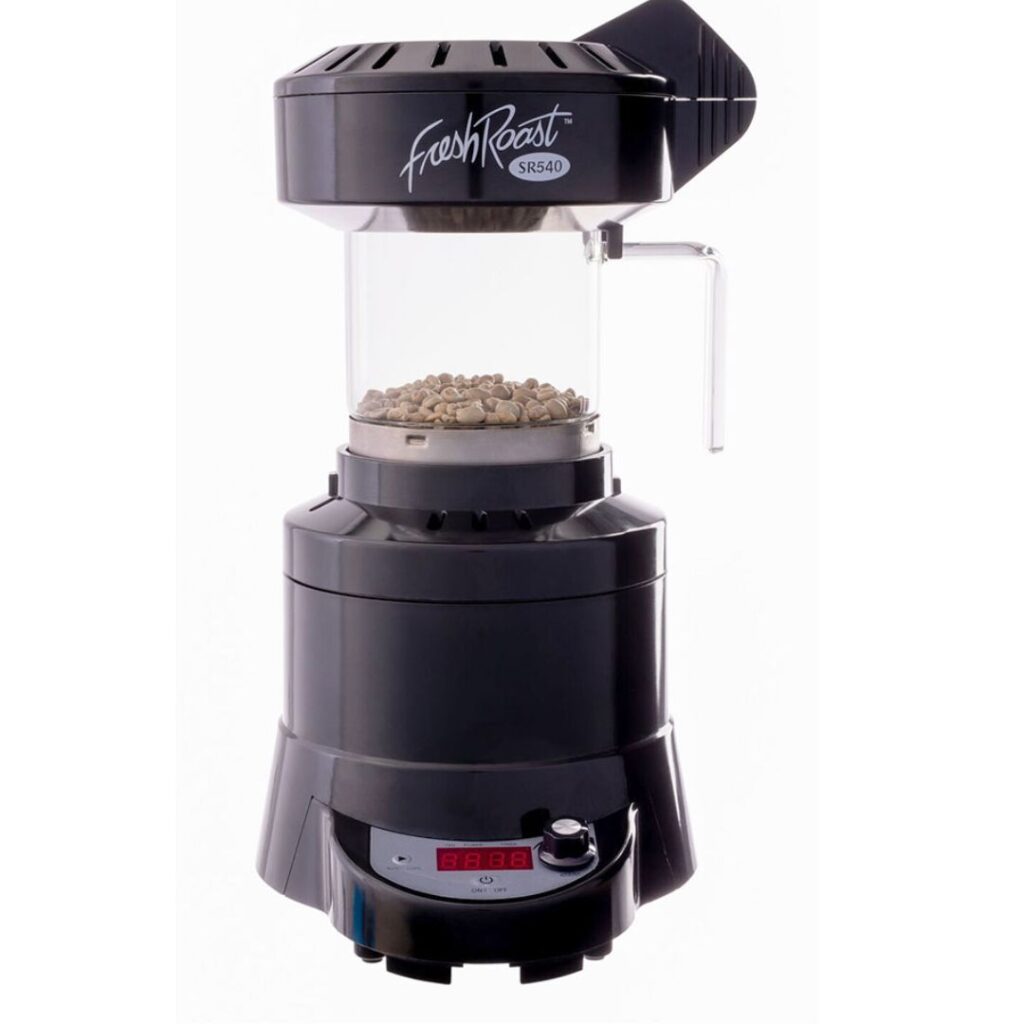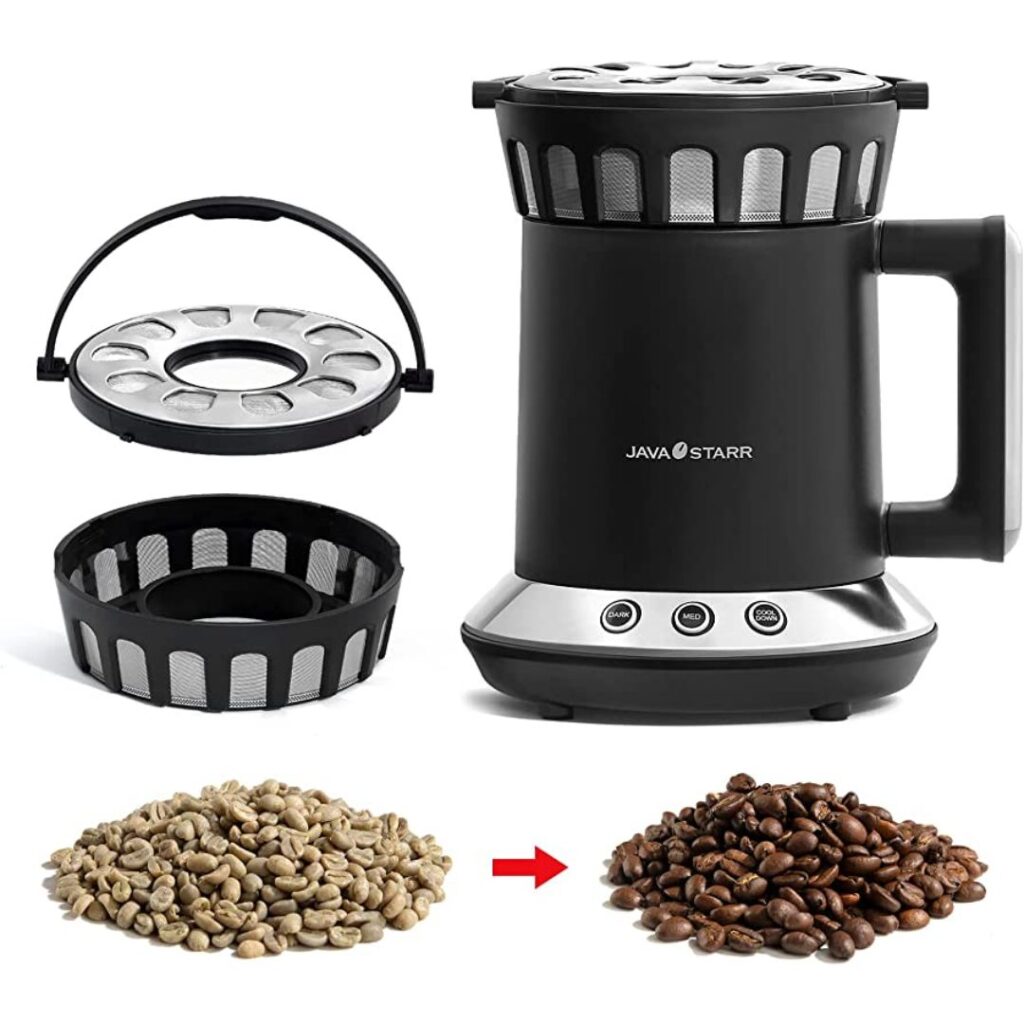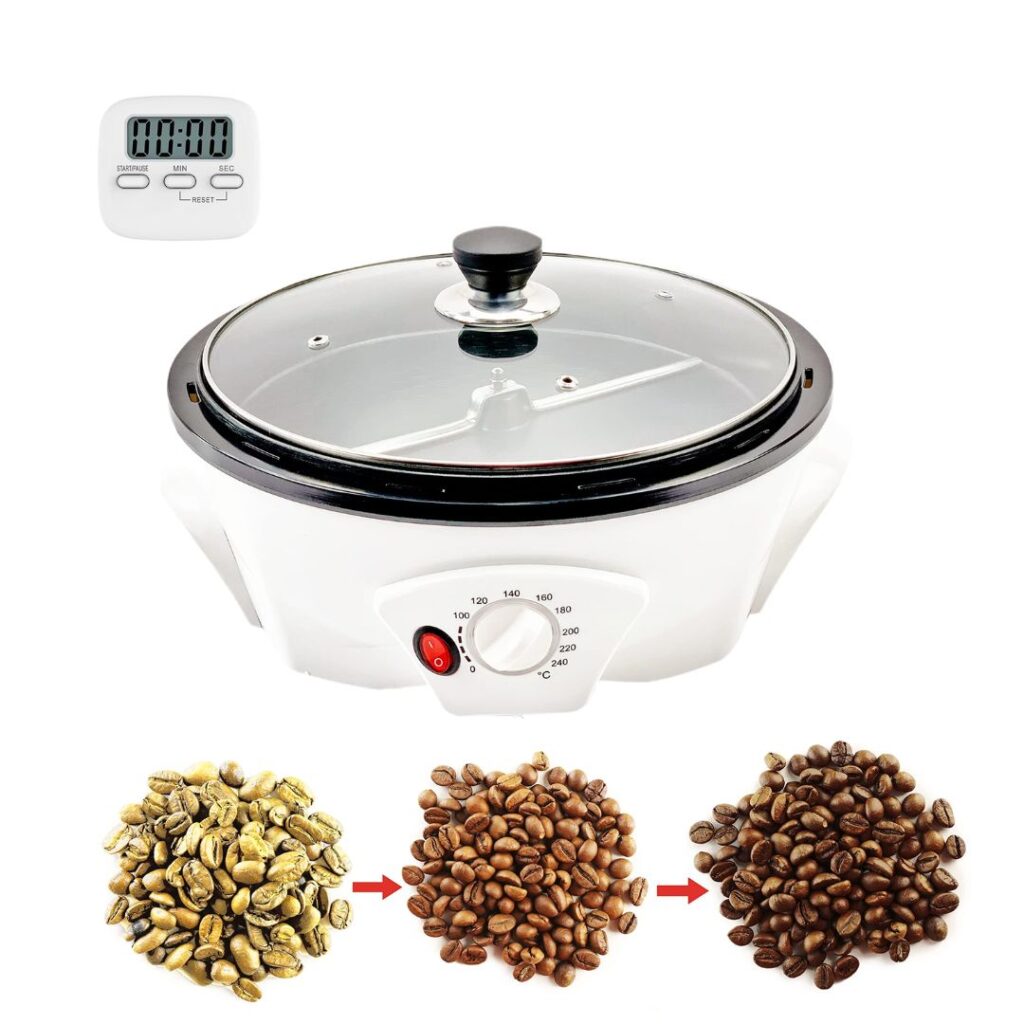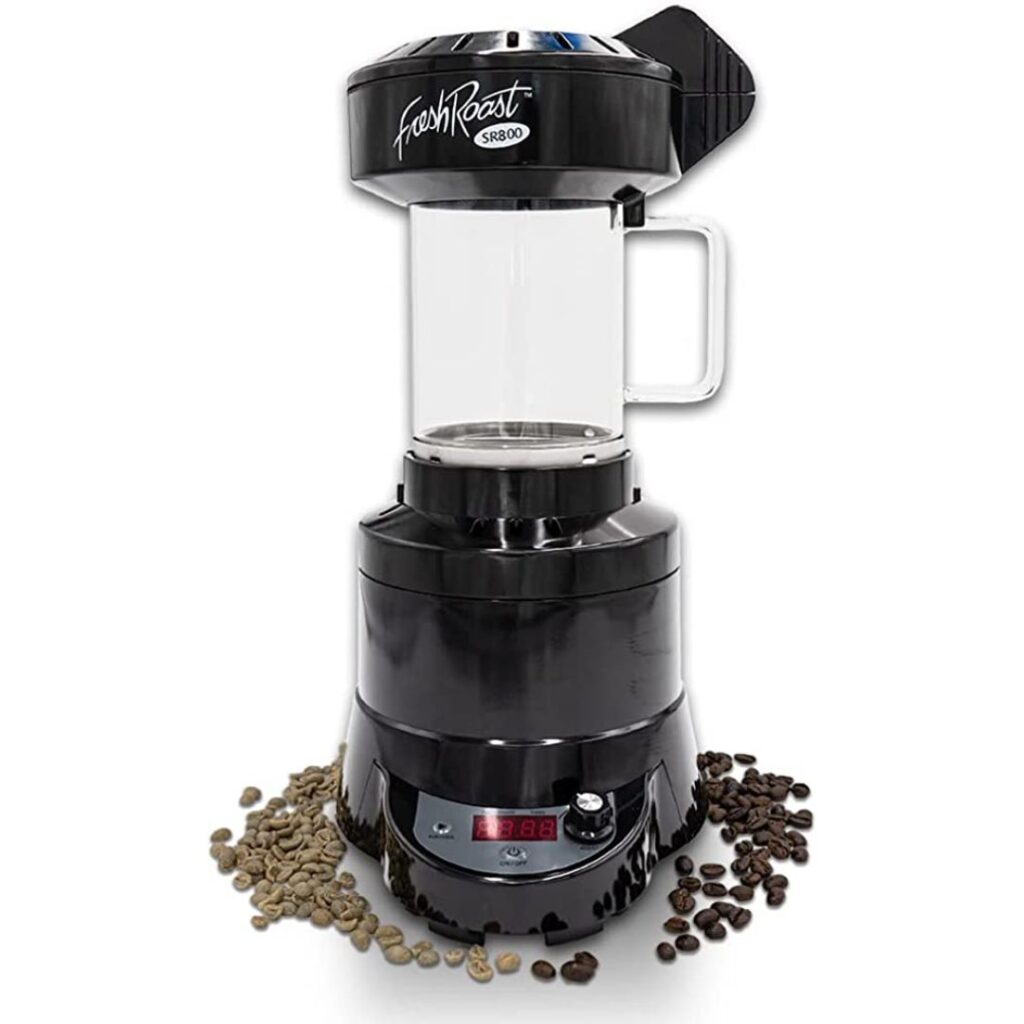Roasting coffee beans at home isn’t for everyone. However, if you’ve got the time and know the difference it makes to the flavor, you’ll understand why a home coffee roaster is a wise investment.
To get you started, here are some of the best home coffee roasters you can currently buy. Be aware, though, that they’re not particularly cheap, so make sure you pick the right one for your needs.
The 5 Best Home Coffee Roasters
Top Overall Pick: Fresh Roast SR540 Coffee Bean Roaster

Fresh Roast SR540 Coffee Bean Roaster
Pros
· 9 heat settings for plenty of flexibility.
· Easy to use roaster.
· Roasts 4oz. of beans at a time.
Cons
· Doesn’t have a stirrer in the roasting chamber.
The Fresh Roast SR540 Coffee Bean Roaster is arguably the best balance of quality and price you’ll find. It has plenty of settings for different roasts and comes with all the functionality needed to produce flavorful coffee.
It roasts 4oz. of coffee beans at a time, which is enough for a day or two’s worth of ground coffee. It’s simple to use, too: you just put the beans in, set the temperature, and let it do its thing.
There are 9 heat settings for different roast strengths, giving you loads of flexibility. It has a fan to help distribute heat more evenly, and a separate chaff chamber for collecting the waste product. While these are fairly standard features, it means you can just collect your roasted beans at the end without any extra work.
There’s not much else to say about this roaster, as it’s a decent model that works well. It plugs into a standard 120V outlet and is rated at 1750W. While this means it’s quite energy intensive, it only runs for 10 minutes or so, meaning it won’t have a major impact on your energy bill.
Its biggest downside is that it doesn’t have a stirrer to move the beans during roasting. While the fan does a decent job on its own, it would be better if there was something to stir the actual beans. You can get around this by stirring the beans yourself.
Top Budget Pick: Javastarr Electric Coffee Roaster

Javastarr Electric Coffee Roaster
Pros
· Decent budget-friendly model.
· Just under 4oz. capacity.
· Easy to clean.
Cons
· Lower wattage means it takes a while to roast beans.
The Javastarr Electric Coffee Roaster is a more entry-level price, meaning it’s a good option for those new to coffee roasting. Its functionality is less than the Fresh Roast model above, but it’s still able to do a good job. If you’re just learning the ropes of coffee roasting, it’s a good option.
Like the Fresh Roast, it has a roasting chamber and separate chaff collector. It dissipates heat using a fan, but you shouldn’t expect a stirrer on a budget model. It’s just as easy to use, though. You add the beans and turn them on, leaving it to roast.
However, it only runs at 1200W. This means it takes longer to roast (around 25 minutes). It’s not the end of the world, but it’s a noticeable difference if you’re roasting in the morning because you’ll be waiting around for it to finish.
Also, it’s only got 2 roast settings: medium and dark. While you don’t really need more than this, it’s good to have some flexibility to accommodate different bean types or personal roasting preferences. However, this is a budget model, and it offers the minimum you need.
In terms of downsides, there aren’t any major ones that haven’t been mentioned. It roasts coffee beans, but the lower heat means it takes longer and roasts unevenly. But considering the price, it’s fine to get you into the idea of coffee roasting.
Top Pick for Large Capacity: Giveroo Coffee Roaster

Giveroo Coffee Roaster
Pros
· Ideal for high capacity.
· Easy to use.
· Stirrer helps distribute heat.
Cons
· Glass lid isn’t a good insulator.
The Giveroo Coffee Roaster has a capacity of 1.1 lbs., making it suitable for those who want to roast larger volumes of coffee at once. While this won’t be necessary for every household, it’ll be a good pick for those who get through a lot of coffee.
To help distribute heat more evenly with the larger capacity, it has a stirring rod in the roasting chamber. This constantly moves the beans to ensure they roast properly, which is a feature the models above lack.
Like the Fresh Roast model, it has a temperature dial rather than roast settings. This gives you flexibility over how dark your beans are roasted and is helpful for different capacities. However, it does mean you’ll need to play around with the temperature settings to find what works best for you.
The overall design is good for the price. The roasting tray is non-stick, and there’s a countdown timer to track the roasting. It’s rated at 1200W and can roast beans in 25 minutes, putting it on par with the Javastarr model.
However, its biggest downside is its lid. It’s made of glass, which doesn’t insulate the roasting chamber very well. While the other models have glass elements, this is quite a large surface area, meaning it can lose a lot of heat. As such, you might find you need to run it on the hottest setting regardless of how dark you want your beans roasted.
Best Value for Money: Fresh Roast SR800 Coffee Bean Roaster

Fresh Roast SR800 Coffee Bean Roaster
Pros
· Good value for money.
· Larger capacity than the SR540.
· More powerful fan helps to move beans around.
Cons
· Doesn’t display real-time temperature.
As the name suggests, the Fresh Roast SR800 Coffee Bean Roaster is a larger-capacity version of the top pick above. Considering it’s not drastically more expensive, this makes it a good value for money. The reason it didn’t win the top spot is because 4oz. (the SR540’s capacity) is more suitable for most households.
This model’s capacity is 8oz., which is equivalent to around 14 cups of coffee. It might be more suitable for larger households that get through a lot of fresh coffee in a day, but others will benefit from the smaller model. After all, you don’t want to bother roasting coffee and then storing it, as it’ll go stale.
Its functionality is identical to the SR540. It has a variable temperature dial with 9 settings, giving you plenty of flexibility over your roasting strength. There’s a chaff basket at the top, which makes removing the waste easily. It also runs on 1750W and can roast the beans in less than 10 minutes.
A benefit of this larger model is that the fan is more powerful. This means it’s able to move the beans via convection, leading to a more even roast than the SR540. In theory, you shouldn’t have to stir the beans manually, although you’ll need to stay around to ensure they roast evenly.
Its main downside is that the control panel doesn’t display the real-time temperature. While this won’t matter much once you’ve got your roasting process down, it can be annoying for when you need to know a specific temperature. Instead, you’ll just have to spend some time playing around with the temperature settings to see what works best.
Top Pick for Manual Roasting: Dyvee Coffee Roaster

Dyvee Coffee Roaster
Pros
· Great for manually roasting beans.
· Fairly large capacity.
· Good alternative to electric-powered roasters.
Cons
· Much easier to burn the beans.
The electric models above could be considered automatic roasters because your manual input is minimal. However, if you want to go really old-school, the Dyvee Coffee Roaster might be the model for you. Rather than running off electrical power, it sits on a gas burner to roast the beans.
As such, you can use it on a gas kitchen hob or portable gas burner. While this might not sound like the most convenient option, it’s arguably a good choice for coffee aficionados who want ultimate control over all roasting factors.
Essentially, it’s a rotating glass drum on a steel frame. You put the coffee beans in the drum and then turn the handle to roast them evenly. However, it does feature a small motor that can turn the drum for you instead.
Its capacity is around 1lb., although you can obviously roast less if you want to. The benefit of using a gas-heated model is that it doesn’t matter if you fill the drum up less. Rather than a risk of burning the beans, you simply roast them for less time.
If you plan to go down the manual route, make sure you don’t leave this roaster unattended. It’ll burn beans in a matter of seconds if it’s left, especially if the heat is high. However, if you’re familiar with bean roasting, you’ll know you should constantly monitor it anyway.
Final Thoughts
Hopefully, one of the home coffee roasters above will be suitable for your needs. The main buying factor is capacity, as this dictates how much coffee you can roast at once. From there, it should be a simple case of finding the roaster that has the best functionality for your preferences.

